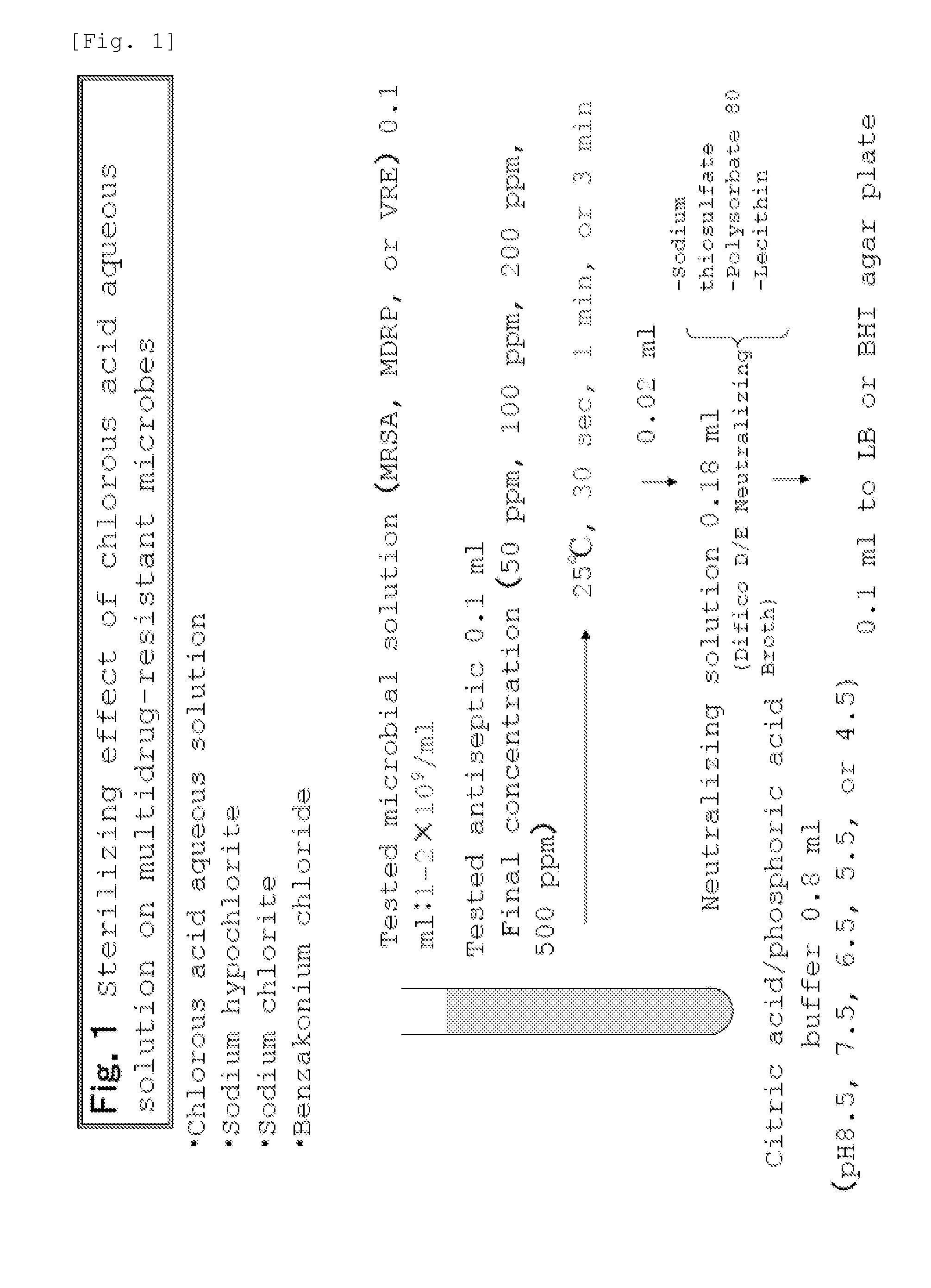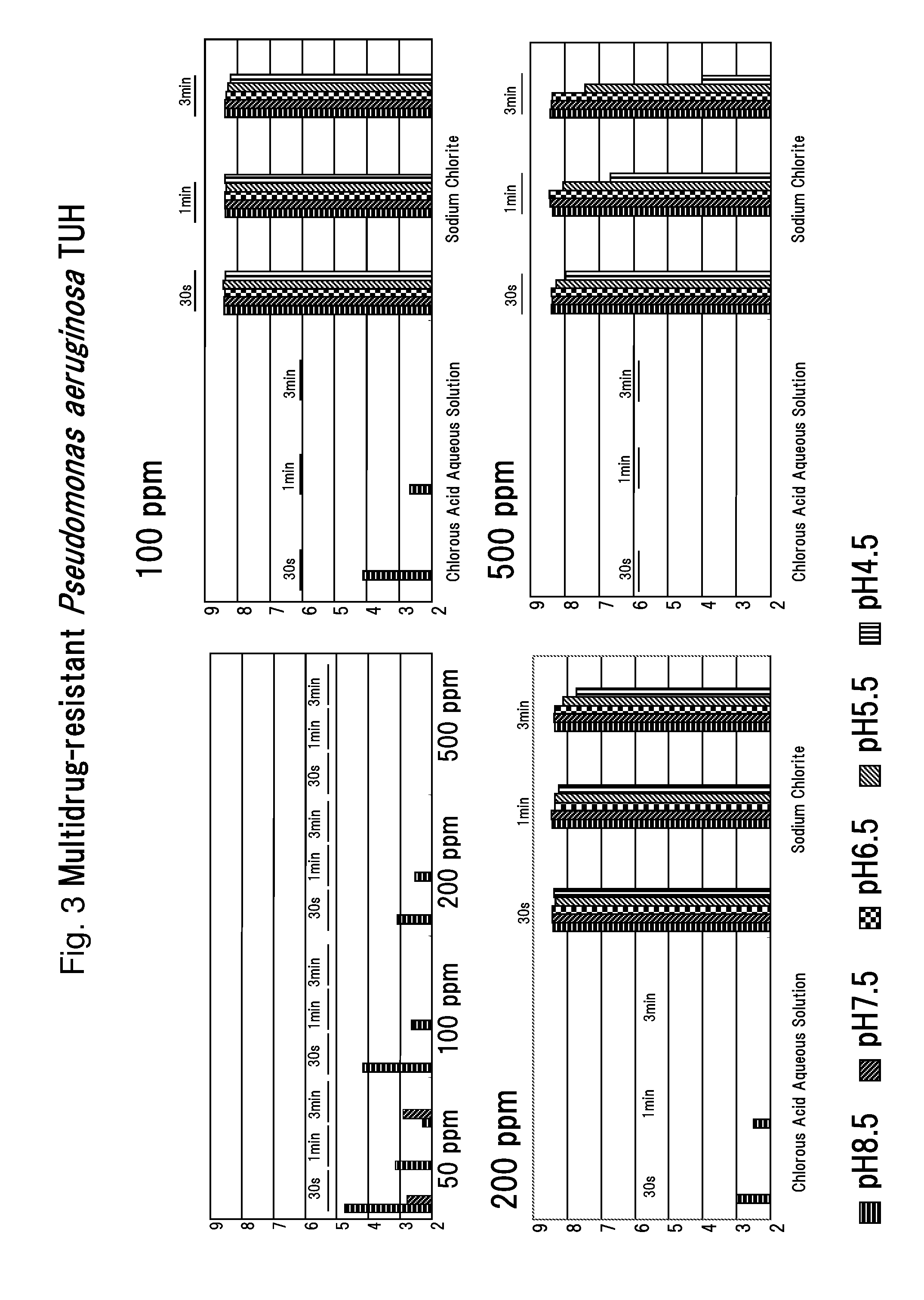Drug-resistant microbe and variant microbe disinfectant containing chlorous acid aqueous solution
a technology of chlorous acid aqueous solution and disinfectant, which is applied in the direction of chlorine active ingredients, biocide, drug compositions, etc., can solve the problems of drug-resistant microbes, old and new problems, and target microbes gradually acquiring resistance, etc., to achieve reliable use, reduce the generation of chlorine dioxide, and the effect of safe in the human body
- Summary
- Abstract
- Description
- Claims
- Application Information
AI Technical Summary
Benefits of technology
Problems solved by technology
Method used
Image
Examples
example 1
Production of Chlorous Acid Aqueous Solution
[0095]The chlorous acid aqueous solution formulation used in the following Example was produced as follows. There are cases herein where an abbreviation “CAAS” is used for a chlorous acid aqueous solution. However, they have the same meaning.
[0096]Component Analysis Table for Chlorous Acid Aqueous Solution
TABLE 2CAASMatch / Not aspecificationSpecification ValueMatchContent4-6%4.1%Attributelight yellowish green to yellowishyellowish redredConfirmation TestWhen 0.1 ml of potassiumMatch(1)permanganate aqueous solution(1→300) is added to 5 ml of anaqueous solution of the presentproduct (1→20), the solution turnsreddish purple. When 1 ml ofsulfuric acid (1→20) is addedthereto, the solution turns lightyellow.Confirmation TestAn aqueous solution of the presentMatch(2)product (1→20) has portions ofThe graph formaximum absorbance atabsorbanceswavelengths 258-262 nm andand wavelengths346-361 nm.is shown inFIG. 7.Confirmation TestIf potassium iodide st...
example 2
Effects on Methicillin-Resistant Staphylococcus Aureus COL
[0105]In the present Example, an effect on methicillin-resistant Staphylococcus aureus was examined. The method was in accordance with the above-described (Method of Measuring Sterilizing Action (Microbe Disinfecting Action)). The results are shown in FIG. 2.
[0106]As shown, it was demonstrated that MRSA was mostly disinfected at about 100 ppm or higher. It was found that MRSA was completely disinfected in a neutral to alkaline region with a high pH of 6.5 or higher at 100 ppm. From the above, in contrast to prior knowledge, a neutral to alkaline region is understood to be preferable for gram-positive microbes such as MRSA. More specifically, it was found that MRSA was completely disinfected in a neutral region with a high pH of 6.5 to 8.5 at 100 ppm, and considering the distinction from sodium chlorite, pH of 6.5 or higher and less than 7.0. From the above, in contrast to prior knowledge, a pH in the neutral region is underst...
examples 3
Effects on Multidrug-Resistant Pseudomonas Aeruginosa TUH
[0107]In the present Example, an effect on multidrug-resistant Pseudomonas aeruginosa was examined. The method was in accordance with that described above (Method of Measuring Sterilizing Action (Microbe Disinfecting Action)). The results are shown in FIG. 3.
[0108]As shown, it was demonstrated that MDRP was mostly disinfected at about 100 ppm or higher and completely disinfected at 500 ppm. In particular, it was found that MDRP was completely disinfected in an acidic region with a low pH of 6.5 or lower even at 50 ppm. From the above, in contrast to prior knowledge, it was found that an antimicrobial effect had a different preferable pH depending on the microbes.
PUM
 Login to View More
Login to View More Abstract
Description
Claims
Application Information
 Login to View More
Login to View More - R&D
- Intellectual Property
- Life Sciences
- Materials
- Tech Scout
- Unparalleled Data Quality
- Higher Quality Content
- 60% Fewer Hallucinations
Browse by: Latest US Patents, China's latest patents, Technical Efficacy Thesaurus, Application Domain, Technology Topic, Popular Technical Reports.
© 2025 PatSnap. All rights reserved.Legal|Privacy policy|Modern Slavery Act Transparency Statement|Sitemap|About US| Contact US: help@patsnap.com



